Cottage Cheese Mac and Cheese is more than just a clever twist on a comfort food favorite, it’s a full-on nutrition upgrade. Traditional mac and cheese tends to be heavy on carbs and fat, but swapping in cottage cheese transforms it into a high-protein powerhouse. Many fitness-focused home cooks say high-protein cottage cheese mac and cheese makes an indulgent dish feel like post-workout fuel.
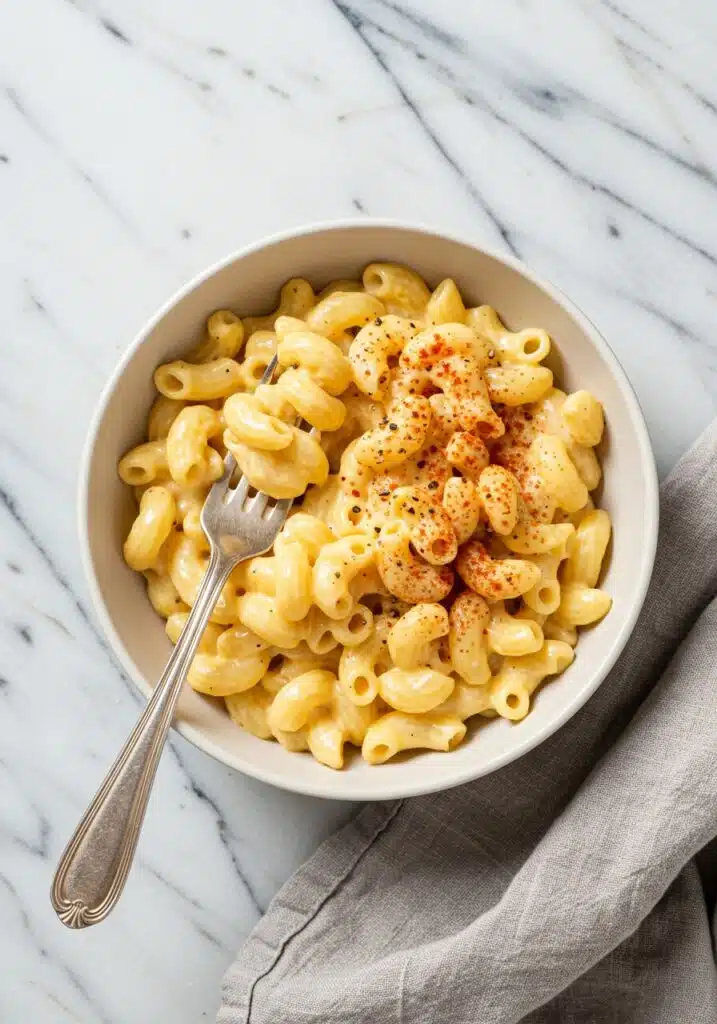
Another reason to love mac and cheese with cottage cheese is its nutritional profile. It’s rich in casein protein, which helps with muscle recovery and satiety. That means cottage cheese mac and cheese recipes keep you fuller, longer, compared to standard versions. And the creamy sauce? Still just as delicious.
This style of mac and cheese is trending right now, just like Cottage Cheese Ice Cream and protein-packed bowls. Honestly, comfort food rarely doubles as a healthy meal, but mac and cheese with cottage cheese really delivers both, in if you can’t stop at one? We’ve got 45 more protein-packed cottage cheese recipes waiting!
Ingredients for High-Protein Cottage Cheese Mac and Cheese
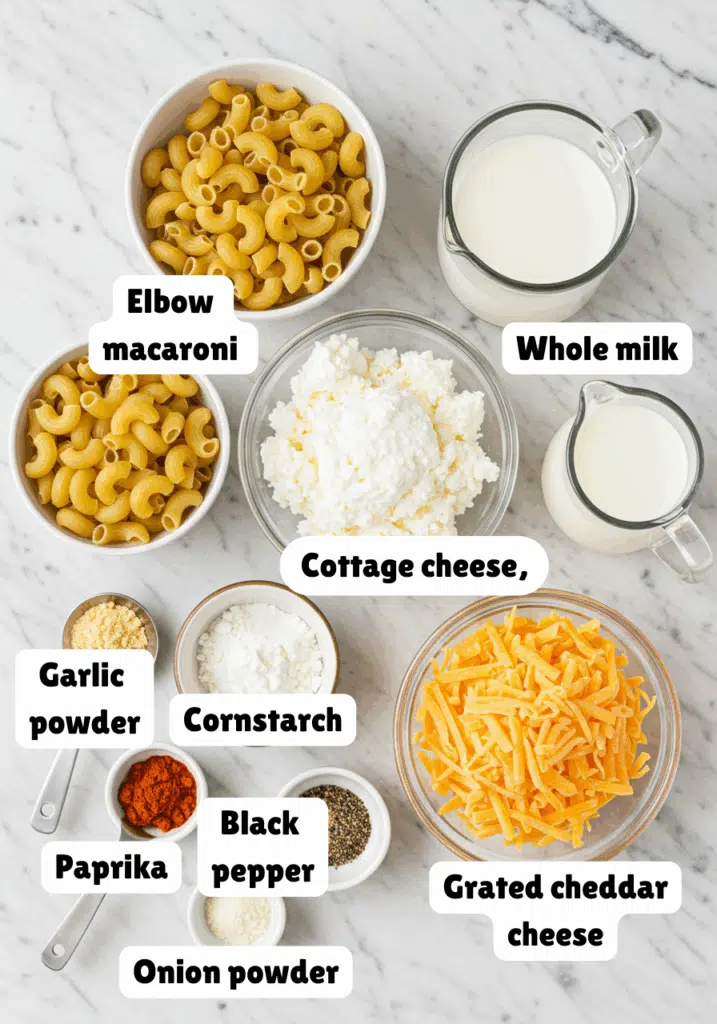
Here’s everything you’ll need to make this creamy, protein-packed dish:
- 8 oz elbow macaroni – classic choice, or swap for lentil/chickpea pasta to boost protein and fiber.
- 1 cup full-fat cottage cheese – the star of the recipe, giving this mac and cheese a protein-rich, creamy base.
- 1 cup whole milk – balances the sauce and keeps it smooth.
- 1 cup freshly grated cheddar cheese – adds sharp flavor and helps achieve that traditional mac and cheese taste.
- 1 tablespoon arrowroot powder or cornstarch – thickens the sauce without heavy cream.
- ½ teaspoon garlic powder – for savory depth.
- ½ teaspoon onion powder – enhances overall flavor.
- ¼ teaspoon paprika – adds a subtle smoky note.
- ¼ teaspoon black pepper – for balance and mild heat.
- Salt to taste – adjust after blending since cottage cheese already contains sodium.
These ingredients prove that cottage cheese mac and cheese recipes don’t need to be complicated. A few smart swaps turn comfort food into a protein-packed dinner.
How to Make Cottage Cheese Mac and Cheese (Step-by-Step)
Follow these simple steps to make the perfect high-protein cottage cheese mac and cheese in under 30 minutes:
1.Cook the pasta – Boil the elbow macaroni according to package directions. Drain and set aside.
2.Blend the sauce – In a blender, combine cottage cheese, whole milk, cheddar cheese, arrowroot powder (or cornstarch), garlic powder, onion powder, paprika, and black pepper. Blend until smooth and creamy.

3.Heat gently – Pour the sauce into a large skillet or saucepan. Cook over medium-low heat for 8–10 minutes, whisking occasionally until the sauce thickens slightly.

4.Combine pasta and sauce – Add the cooked pasta to the skillet and stir until every noodle is coated. The sauce may seem thin at first but will thicken as it sits.
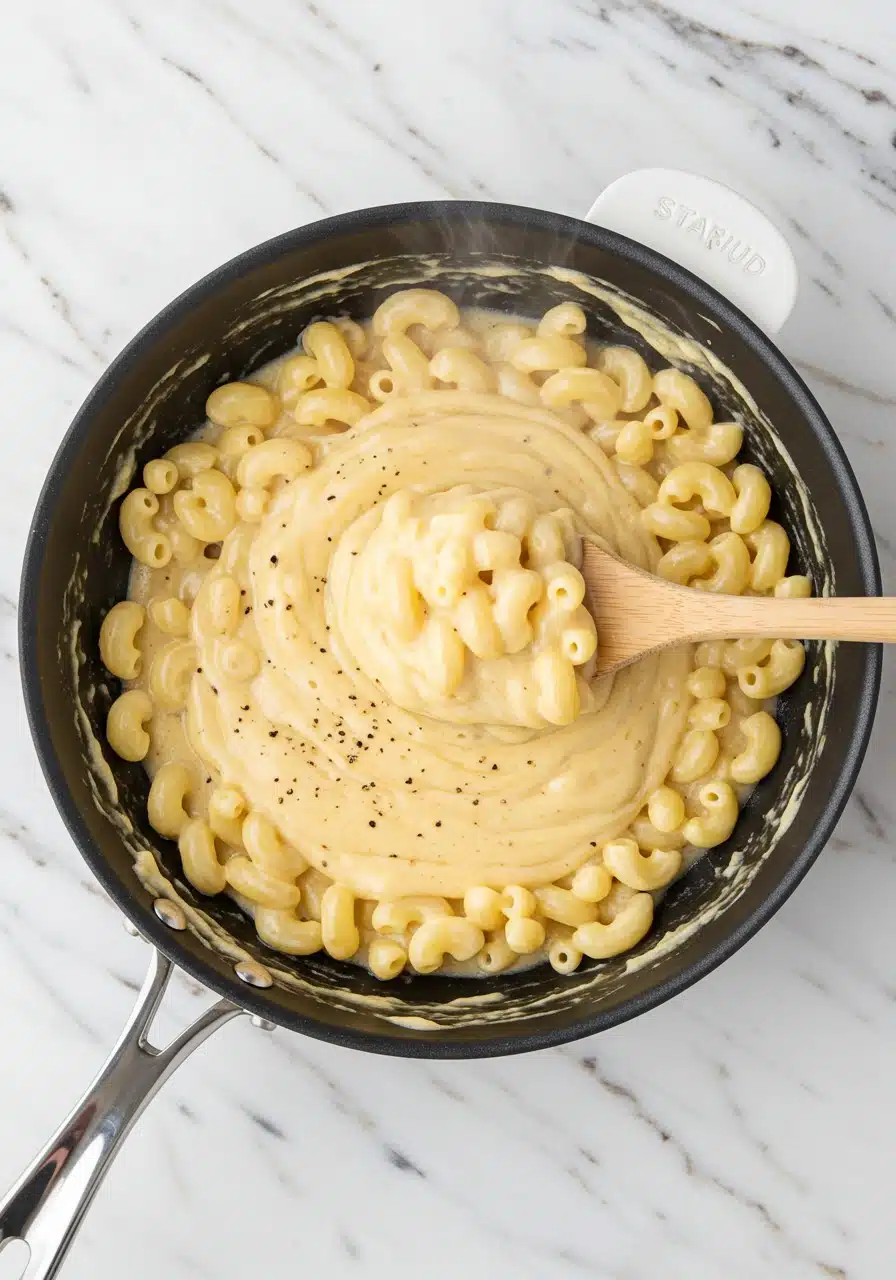
5.Taste and adjust – Add extra salt or spices if needed. Serve hot and enjoy!
This step-by-step method is inspired by popular high-protein cooking hacks where cottage cheese gets blended into sauces. It’s quick, efficient, and results in a creamy mac and cheese that tastes indulgent but fuels your goals.
Tips for the Best Cottage Cheese Mac and Cheese
Want to take your cottage cheese mac and cheese from good to unforgettable? These tips make all the difference. First, always blend the sauce completely. A smooth sauce is the secret to a silky, luxurious texture. Freshly grated cheddar melts better than bagged cheese, which helps avoid clumps.
Heat matters too. For the creamiest high-protein cottage cheese mac and cheese, keep the burner on medium-low. Too much heat too quickly can ruin that velvety consistency. Taste before adding extra salt, since cottage cheese already carries sodium.
For an extra protein punch, try lentil pasta or chickpea pasta. They work beautifully with this sauce and make your mac and cheese with cottage cheese even more filling. We’ve seen the same trick work in our Cottage Cheese Pasta Sauce, and it’s one worth keeping in your back pocket.
Variations and Add-Ins
One of the best parts of cottage cheese mac and cheese is how easy it is to customize. Think of the basic recipe as your blank canvas. Want more protein? Add chicken breast, tuna, or turkey bacon for a heartier high-protein cottage cheese mac and cheese bowl. If you’re vegetarian, chickpeas or edamame blend right in.
Vegetables like broccoli, spinach, or peas not only add color but also balance the richness of the cheese sauce. For spice lovers, jalapeños or hot sauce bring the heat. If you’re craving cozy vibes, sprinkle breadcrumbs on top and bake it into a crispy baked cottage cheese mac and cheese.
Food communities often share creative twists like swapping half the pasta for cauliflower or stirring in Greek yogurt. And just like with our Cottage Cheese Taco Bowl, this dish shines because of its adaptability. At the end of the day, there’s no wrong way to enjoy mac and cheese with cottage cheese, it’s comfort food with a protein upgrade.
Storage, Reheating & Meal Prep for Cottage Cheese Mac and Cheese
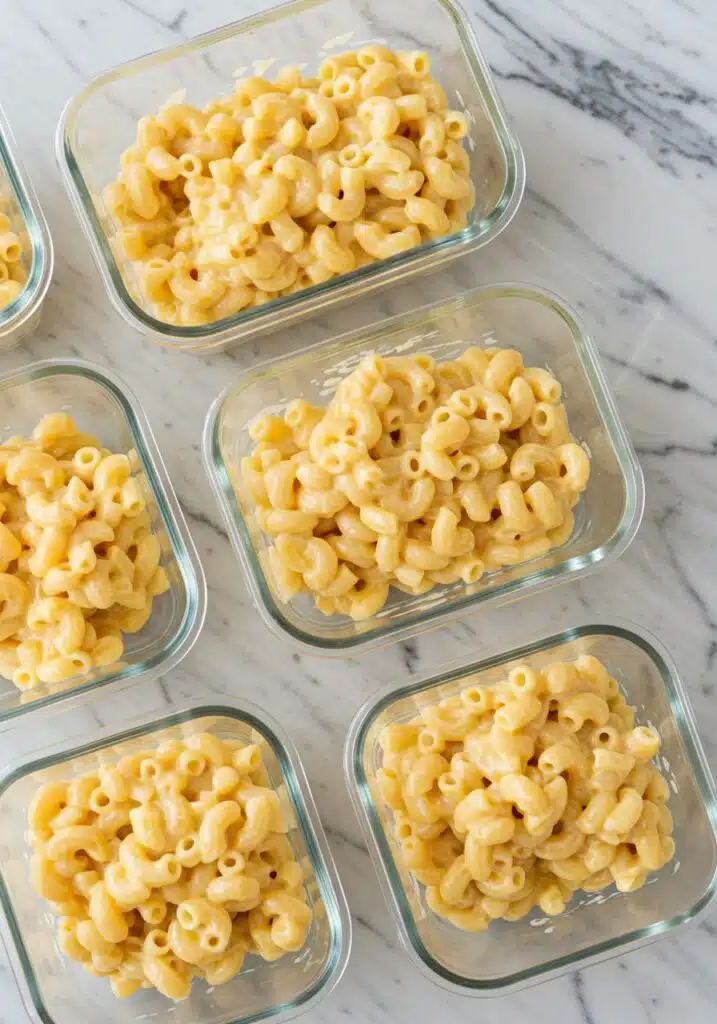
One of the best parts about Cottage Cheese Mac and Cheese is how well it works for meal prep. Unlike some creamy pastas that dry out quickly, this version reheats nicely because of the blended sauce. Store leftovers in an airtight container in the fridge for 3–4 days. When you’re ready to reheat, add a splash of milk before microwaving or warming on the stovetop, this helps bring back that silky texture.
For longer storage, freeze portions in single-serve containers. Many home cooks swear that freezing high-protein pasta dishes helps with portion control and quick weeknight dinners. Just thaw overnight in the fridge, then reheat gently. If you want to meal prep in bulk, divide the cottage cheese mac and cheese into four portions, pair with a side of veggies or lean protein, and you’ve got balanced meals ready to go.
One common frustration is reheated pasta becoming gummy. To avoid this, slightly undercook the noodles the first time around, since they’ll soften more when reheated. It’s the same trick people use in baked pasta recipes. Honestly, once you nail this routine, high-protein cottage cheese mac and cheese can be your go-to for easy, make-ahead comfort food.
Nutrition Breakdown (Macros per Serving)
Here’s where Cottage Cheese Mac and Cheese really shines. Each serving delivers around 22 grams of protein, thanks to the cottage cheese and cheddar. That’s nearly double the protein of regular mac and cheese. With about 417 calories, 15 grams of fat, and 48 grams of carbs, this recipe balances comfort with fuel.
Protein-rich meals like this are especially helpful for people who lift weights, stay active, or just want longer-lasting energy. The cottage cheese adds casein protein, which digests slowly and helps with satiety, while the cheddar contributes both flavor and whey protein. Compared to traditional mac and cheese, which often leaves you hungry again in a couple of hours, this high-protein cottage cheese mac and cheese keeps you satisfied.
If you want to tweak macros, swap in chickpea pasta to increase fiber and plant protein, or use low-fat cottage cheese to reduce fat while still keeping protein high. Many nutrition-conscious home cooks make small swaps like this to fit their goals. For more insights on macro-friendly meals, you can also explore resources from Healthline that dive into cottage cheese benefits.
Bottom line: this dish isn’t just tasty, it’s a nutrition win.
Cottage Cheese vs Other Cheeses in Mac and Cheese
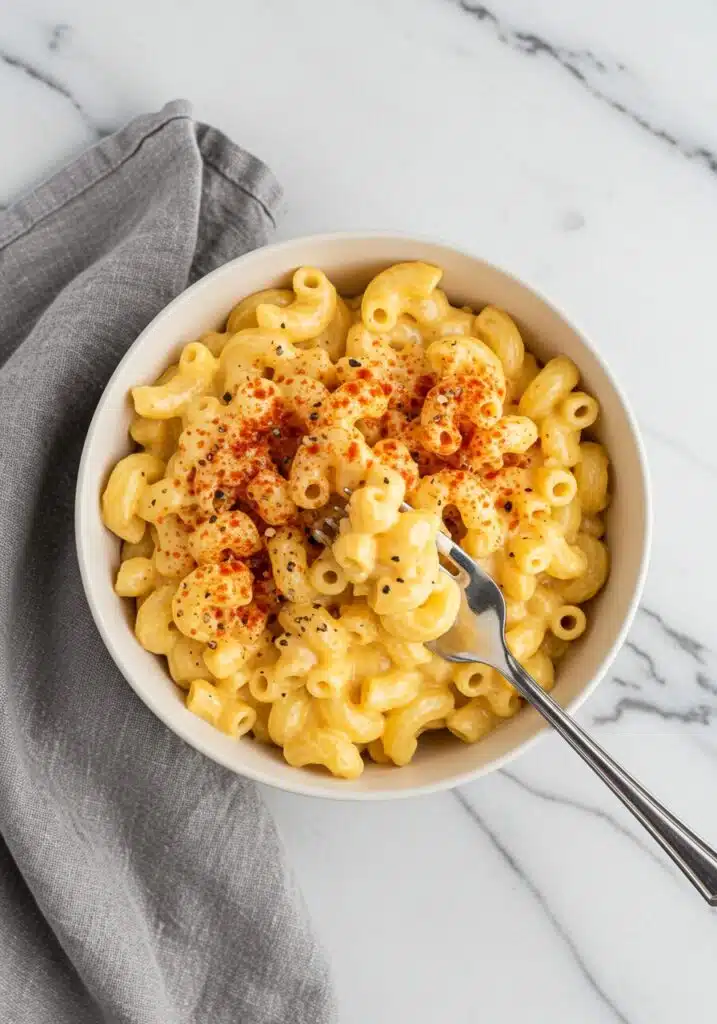
Why choose Cottage Cheese Mac and Cheese over other cheesy versions? It comes down to nutrition and texture. Traditional mac and cheese relies on heavy cream, butter, and lots of cheddar. While delicious, it’s high in fat and low in protein. Cottage cheese changes the game. It adds creaminess without the extra grease and brings a protein punch that cream cheese or ricotta can’t match.
Compared to ricotta, cottage cheese has nearly double the protein per cup. Against cream cheese, it’s not even close, cream cheese is mostly fat. Even Greek yogurt, which is also high in protein, doesn’t create quite the same rich, thick sauce that cottage cheese delivers. That’s why more and more recipes are shifting toward mac and cheese with cottage cheese as the base.
If you’re still skeptical, try blending cottage cheese into other sauces first. Many people are surprised at how smooth it becomes. We covered this trick in our Greek Cottage Cheese Bowl too, it’s proof that cottage cheese is way more versatile than people give it credit for. In the end, cottage cheese mac and cheese proves you can have the classic flavor you crave with nutrition that supports your goals.
More High-Protein Cottage Cheese Recipes You’ll Love
If this Cottage Cheese Mac and Cheese has you hooked, you’ll want to explore other high-protein meals using the same superstar ingredient. Cottage cheese is one of the most versatile ingredients out there, it works in both sweet and savory dishes.
For breakfast, try our Blueberry Cottage Cheese Breakfast Bake. It’s packed with protein but tastes like dessert. For something savory, our High-Protein Buffalo Chicken Dip is a party favorite that doubles as a post-workout snack. And if you’re craving pasta again, don’t miss the High-Protein Cottage Cheese Pasta Sauce, it’s creamy, tangy, and just as macro-friendly.
At the end of the day, this high-protein cottage cheese mac and cheese is just the beginning. Once you start cooking with cottage cheese, you’ll realize how many possibilities are waiting.
Frequently Asked Questions (FAQs)
Is cottage cheese actually high in protein?
Absolutely! Cottage cheese is naturally high in protein, especially casein protein, which digests slowly and keeps you fuller for longer. A single cup can provide around 25 grams of protein, making it an excellent choice for high-protein meals like cottage cheese mac and cheese. Many fitness-focused cooks use it in both sweet and savory dishes because it’s versatile and nutrient-dense.
What does cottage cheese do to mac and cheese?
Cottage cheese transforms the classic mac and cheese into a creamy, protein-packed dish. When blended, it creates a smooth, velvety sauce that still has that indulgent texture everyone loves. Using cottage cheese in mac and cheese with cottage cheese adds extra protein without adding excess fat, making it a smart swap for health-conscious and high-protein meal planning.
Can I substitute cottage cheese for milk in mac and cheese?
Yes, in many recipes, you can partially substitute cottage cheese for milk to increase protein and creaminess. For example, in high-protein cottage cheese mac and cheese, the cottage cheese forms the base of the sauce while milk helps adjust consistency. Just blend well to avoid curds and maintain a smooth, rich texture.
What do bodybuilders eat with cottage cheese?
Bodybuilders often pair cottage cheese with foods that balance macros. Common combos include fruit, veggies, whole-grain carbs, or even lean proteins like chicken or turkey. Using cottage cheese in mac and cheese is a perfect example, it creates a hearty, protein-rich meal that’s satisfying and supports muscle-building goals.
Final Thoughts
This Cottage Cheese Mac and Cheese proves you don’t have to sacrifice taste for protein. By blending cottage cheese into the sauce, you get a creamy, indulgent dish that fuels your body and keeps you full longer. Whether you’re meal-prepping for the week, craving a comfort-food favorite, or looking for a high-protein dinner that’s easy to make, this recipe delivers on all fronts.
Don’t be afraid to experiment, add veggies, lean protein, or spices to make it your own. Store leftovers in an airtight container in the fridge for up to 3–4 days and reheat gently to maintain the creamy texture.
Try this high-protein cottage cheese mac and cheese and see how a simple swap can transform a classic comfort food into a nutrient-packed meal. Have tips or variations you love? Share them with the community, we’d love to hear how you make this recipe your own!
Print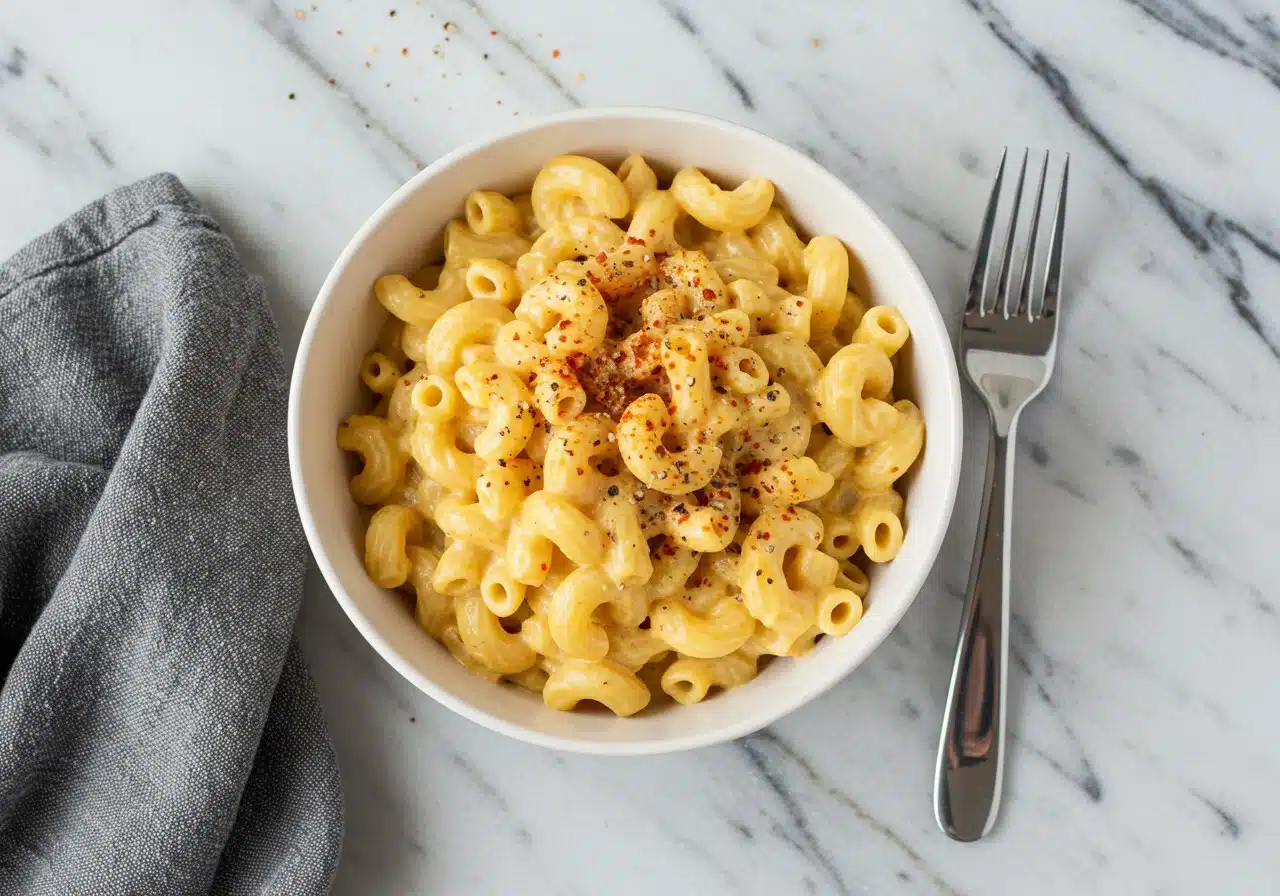
cottage cheese mac and cheese recipe
- Total Time: 25 minutes
- Yield: 4 servings 1x
Description
This Cottage Cheese Mac and Cheese is a high-protein twist on the classic comfort food. Creamy, cheesy, and satisfying, it uses cottage cheese blended into the sauce for extra protein without sacrificing flavor.
Ingredients
- 8 oz elbow macaroni noodles
- 1 cup full fat cottage cheese
- 1 cup whole milk
- 1 cup freshly grated cheddar cheese
- 1 Tablespoon arrowroot powder or cornstarch
- 1/2 teaspoon garlic powder
- 1/2 teaspoon onion powder
- 1/4 teaspoon paprika
- 1/4 teaspoon black pepper
- Salt to taste
Instructions
- Cook the pasta according to package directions. Drain and set aside.
- While the pasta is cooking, add the cottage cheese, milk, cheddar cheese, arrowroot powder, garlic powder, paprika and black pepper to a blender. Blend until smooth.
- Pour the blended cheese sauce into a large skillet or saucepan. Heat over medium-low for about 8-10 minutes, whisking occasionally, until the sauce thickens slightly.
- Add the cooked pasta to the sauce and stir until fully coated. Let sit for a few minutes to thicken more.
- Taste and adjust seasonings with extra salt or pepper if needed. Serve warm and enjoy!
Notes
- Storage: Store any leftovers in an airtight container in the fridge for up to 3-4 days.
- The sauce may seem thin at first but will thicken as it cools slightly.
- Use whole wheat or chickpea pasta for extra fiber and protein.
- Prep Time: 5 minutes
- Cook Time: 20 minutes
- Category: Dinner, Main Course, High-Protein
- Method: Stovetop
- Cuisine: American, Comfort Food
Nutrition
- Serving Size: 1/4 recipe
- Calories: 417
- Sugar: 7g
- Sodium: 397mg
- Fat: 15g
- Saturated Fat: 9g
- Unsaturated Fat: 6g
- Trans Fat: 0g
- Carbohydrates: 48g
- Fiber: 2g
- Protein: 22g
- Cholesterol: 49mg


